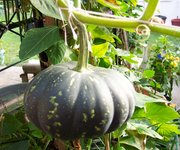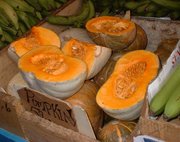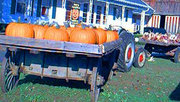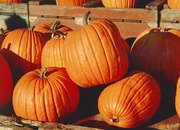Introduction
A pumpkin is the fruit of the gourd Cucurbita pepo, Cucurbita maxima, Cucurbita mixta, or Cucurbita moschata, a native plant of the Western hemisphere. Today, it is well-known in English cottage gardens, and largely cultivated in continental Europe and North America.

The pumpkin varies greatly in form, being sometimes nearly globular, but more generally oblong or ovoid in shape. The rind is smooth and very variable in colour. The larger kinds acquire a weight of 40 to 80 lb (18 to 36 kg) but smaller varieties are in vogue for garden culture.
Pumpkins and squashes
The name "squash" is applied in America to this and other species of the genus Cucurbita. The name is adapted from an American Indian word (see L. H. Bailey, Cyclopaedia of American Horticulture, for a fuller account of the squashes).

Summer squashes, like pumpkins, are mostly varieties of Cucurbita pepo; if picked while immature they are eaten as summer squash or marrow, but if left to mature on the vine will form a hard fruit like winter squash. Winter squashes are either C. maxima or C. moschata, and are not eaten in immature form. The varieties of pumpkins and squashes are numerous and great variety in size and shape; it is difficult to keep them pure if various kinds are grown together, but the true squashes (C. maxima) do not hybridize with the true pumpkin (C. pepo) species. If carefully handled to avoid cracking of the skin, and kept dry and fairly warm, winter squashes may be kept for months.

Studies by the Royal Military College of Canada show promise for pumpkins and other members of the Cucurbita pepo family to be viable candidates for DDT phytoremediation. (see Scientific American, October 25, 2004)
Cultivation
Pumpkins have historically been pollinated by the native squash bee Peponapis pruinosa, but this bee has declined, probably due to pesticide sensitivity, and most commercial plantings are pollinated by honeybees today. One hive per acre (4,000 m˛ per hive) is recommended by the US Department of Agriculture. Gardeners with a shortage of bees, however, often have to hand pollinate.
Inadequately pollinated pumpkins usually start growing but abort before full development. Often there is an opportunistic fungus that the gardener blames for the abortion, but the solution to this problem of abortion tends to be better pollination rather than fungicide.
Pumpkins are grown today in the US more for decoration than for food, and popular contests continually lead growers to vie for the world record for the largest pumpkin ever grown. Growers have many techniques, often secretive, including hand pollination, removal from the vines of all but one pumpkin, and injection of fertilizer or even milk directly into the vines with a hypodermic needle.
Cooking
When ripe, the pumpkin can be boiled, baked and roasted, or made into various kinds of pie, alone or mixed with other fruit; while small and green it may be eaten in the same way as the vegetable marrow.
Pumpkin trivia
- The pumpkin is actually a fruit. It is, however, related to the cucumber.
- The largest pumpkin ever grown weighed 1,458 lb (661 kg). Raised by Bruce Whittier from Henniker, New Hampshire, it is technically a "squash," Cucurbita maxima, and was of the public variety "Atlantic Giant," which is the "giant" variety - culminated from the simple hubbard squash by enthusiast farmers through intermittent effort since the mid 1800's.
- Pumpkins are orange because they contain massive amounts of lutein, alpha- and beta-carotene. These nutrients turn to vitamin A in the body.
- Using pumpkins as lanterns at Halloween is based on an ancient Celtic custom brought to America by Irish immigrants. All Hallows Eve on October 31st marked the end of the old Celtic calendar year, and on that night hollowed-out turnips, beets and rutabagas with a candle inside were placed on windowsills and porches to welcome home spirits of deceased ancestors and ward off evil spirits and a restless soul called “Stingy Jack - hence the name "Jack O’ Lantern".
- The town of Keene, New Hampshire currently holds the world record for the most lit pumpkins in one location.
- 90% of all pumpkins sold in the United States are used for Jack O’ Lanterns.
- In colonial New Haven, Connecticut, cut pumpkins were used as guides for haircuts to ensure a round, uniform style. Because of this fashion, New Englanders were nicknamed "pumpkin-heads."
- Illinois produces more pumpkins than any other state in the United States.
Pumpkin seed oil
One of the typical pumpkin products of Austria is pumpkin seed oil.
References
- Illinois Leads Nation in Pumpkin Production (http://www.agr.state.il.us/newsrels/r1022041.html), Illinois Department of Agriculture.
- The Largest Pumpkin Ever (http://www.bigpumpkins.com/viewarticle.asp?id=115&gid=32), bigpumpkins.com.
Resources
- Giant Pumpkin Web Directory
- Pumpkin Nook (http://www.pumpkinnook.com)
- BigPumpkins.com (http://www.bigpumpkins.com)

